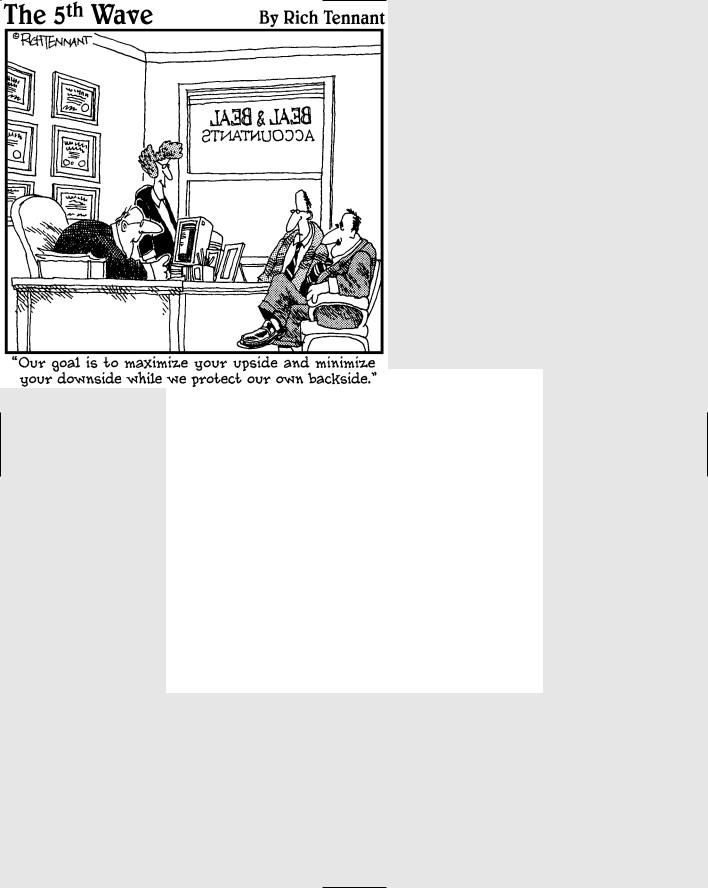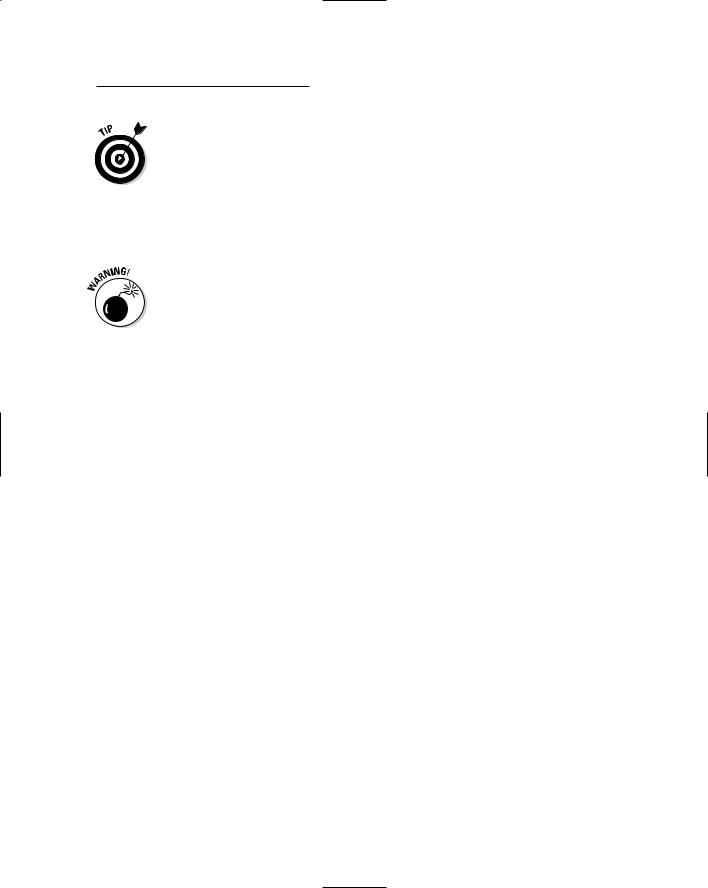
Accounting For Dummies, 4th edition
.pdf
320 Part IV: Preparing and Using Financial Reports
and public companies now have two bosses, one for their private business clients and one for their public business clients.
The PCAOB has ruled that many consulting and other services that CPA firms used to provide to their audit clients are now out of bounds. The firms can offer these services to public businesses that they don’t audit, but not to their audit clients. The thinking is that the auditor cannot be truly independent if the firm also derives substantial revenue from selling non-audit services to the same client that it audits. (In the past, many people criticized these conflicts of interest.)
The role, authority, and responsibilities of audit committees of public businesses have also become more prominent in recent years. An audit committee is a subcommittee of the board of directors of a business corporation. Audit committee members now must be outside directors, meaning they have no management position in the business. Outside directors are often considered more independent, more objective, and more willing to challenge the executives of the business on serious issues facing the business. The audit committee works closely with the independent CPA auditor on any issues and problems that come up during the audit.

Part V
The Part of Tens

In this part . . .
This part contains two shorter chapters: the first directed to business managers, and the second
directed to business investors and other outside readers of financial reports. The first chapter presents ten tips for business managers to help them get the most bang for the buck out of their accounting system; these ten topics constitute a compact accounting tool kit for managers. The second chapter offers investors ten tips regarding what they should keep in mind and what to look for when reading a financial report — to gain the maximum amount of information in the minimum amount of time.

Chapter 16
Ten Accounting Tips for Managers
In This Chapter
Getting a grip on profit analytics
Putting your finger on the pulse of cash flow
Taking charge of your business’s accounting policies
Using sensible budgeting techniques
Getting the accounting information you need
Knowing how to talk about your financial statements
Financially speaking, business managers have three jobs:
Earn adequate profit consistently
Generate cash flow from profit
Control the financial condition of the business
How can accounting help make you a better business manager? That’s the bottom-line question, and the bottom line is the best place to start. Accounting provides the financial information you need for making good profit decisions — and it stops you from plunging ahead with gut-level decisions that feel right but don’t hold water after due-diligent analysis. Accounting also provides cash flow and financial condition information
you need. But in order for accounting information to do all these wonderful things, you have to understand and know how to interpret it.
Reach Break-Even, and
Then Rake in Profit
Almost every business has fixed costs: costs that are locked in for the year and remain the same whether annual sales are at 100 percent or below half your capacity. Fixed costs are a dead weight on a business. To make profit,

324 Part V: The Part of Tens
you have to get over your fixed costs hurdle. How do you do this? Obviously, you have to make sales. Each sale brings in a certain amount of margin, which equals the revenue minus the variable expenses of the sale.
Say you sell a product for $100. Your purchase (or manufacturing) cost is $60, which accountants call the cost of goods sold expense. Your variable costs of selling the item add up to $15, including sales commission and delivery cost. Thus, your margin on the sale is $25: $100 sales price – $60 product cost – $15 variable costs = $25 margin. (Margin is before interest and income tax expenses.)
Your annual fixed operating costs total $2.5 million. These costs provide the space, facilities, and people that are necessary to make sales and earn profit. Of course, the risk is that your sales will not be enough to overcome your fixed costs. This leads to the next step, which is to determine your breakeven point. Break-even refers to the sales revenue you need just to recoup your fixed operating costs. If you earn 25 percent average margin on sales, in order to break even you need $10 million in annual sales: $10 million × 25 percent margin = $2.5 million margin. At this sales level, margin equals fixed costs and your profit is zero (you break even). Not very exciting so far, is it? But from here on it gets much more interesting.
Until sales reach $10 million, you’re in the loss zone. After you cross over the break-even point, you enter the profit zone. Suppose your annual sales revenue is $16 million, or $6 million over your break-even point. Your profit
(earnings before interest and income tax) is $1.5 million ($6 million sales over break-even × 25 percent margin ratio = $1.5 million profit). After you cross over the break-even threshold, your entire margin goes toward profit; each additional $100 sale generates $25 profit. Suppose, for example, that you had made $1 million in additional sales. You would earn $250,000 more profit — an increase of 16.7 percent over the profit earned on $16 million sales revenue.
Set Sales Prices Right
In real estate, the three most important profit factors are location, location, and location. In the business of selling products and services, the three most important factors are margin, margin, and margin. Of course a business manager should control expenses — that goes without saying. But the secret to making profit is making sales and earning an adequate margin on them. (Remember, margin equals sales price less all variable costs of the sale.) Chapter 9 explains that internal P&L reports to managers should clearly separate variable and fixed costs so the manager can focus on margin.

Chapter 16: Ten Accounting Tips for Managers 325
In the example in the previous section, your sales prices earn 25 percent margin on sales. In other words, $100 of sales revenue generates $25 margin (after deducting the cost of product sold and variable costs of making the sale). Therefore, $16 million in sales revenue generates $4 million margin. The $4 million margin covers your $2.5 million in fixed costs and provides $1.5 million of profit (before interest and income tax).
An alternative scenario illustrates the importance of setting sales prices high enough to earn an adequate margin. Instead of the sales prices in the previous example, suppose you had set sales prices 5 percent lower. Therefore, your margin would be $5 lower per $100 of sales. Instead of 25 percent margin on sales, you would earn only 20 percent margin on sales. How badly would the lower margin ratio hurt profit?
On $16 million annual sales, your margin would be $3.2 million ($16 million sales × 20 percent margin ratio = $3.2 million margin). Deducting $2.5 million fixed costs for the year leaves only $700,000 profit. Compared with your $1.5 million profit at the 25 percent margin ratio, the $700,000 profit at the lower sales prices is less than half. The moral of this story is that a 5 percent lower sales price causes 53 percent lower profit!
Distinguish Profit from Cash Flow
To find out whether you made a profit or had a loss for the year, you look at the bottom line in your P&L report. But you must understand that the bottom line does not tell you cash flow from your profit-making activities. Profit does not equal cash flow. Don’t ever assume that making profit increases cash the same amount. Making such an assumption reveals that you’re a rank amateur. Cash flow can be considerably higher than bottom-line profit, or considerably lower. Cash flow can be negative even when you earn a profit, and cash flow can be positive even when you have a loss. There’s no natural correlation between profit and cash flow. If I know one of the numbers, I don’t have a clue about the other.
Figure 16-1 shows an example I designed to illustrate the differences between sales revenue and expenses (the accounting numbers used to measure profit) and the cash flows of the sales and expenses. Only three expenses are shown: cost of goods sold, depreciation, and one total amount for all other expenses. (Note: Reporting expenses this way is not adequate for managers in a P&L report and is not acceptable for income statements in an external financial report.)

326 Part V: The Part of Tens
Figure 16-1: |
|
P&L Report |
|
Cash Flows |
|
Differences |
|
|
|
|
|
|
|
||
Comparing |
Sales revenue |
$5,000,000 |
$4,900,000 |
($100,000) |
|||
sales and |
Cost of goods sold expense |
($3,000,000) |
($3,225,000) |
($225,000) |
|||
expenses |
Depreciation expense |
($100,000) |
$0) |
$100,000 |
|||
and their |
All other expenses |
($1,600,000) |
|
($1,435,000) |
|
$165,000 |
|
cash flows. |
|||||||
Bottom line |
$300,000 |
$240,000 |
($60,000) |
||||
|
|||||||
|
|
|
|
|
|
|
|
Here are the reasons for the cash flow differences in Figure 16-1:
Your accounts receivable (from credit sales) increased $100,000 during the year, so actual cash collections from customers were only $4.9 million during the year — a cash flow shortfall of $100,000.
You built up your inventory $225,000 during the year, so your cash outlays for products were $225,000 higher than the cost of goods sold expense for the year.
Depreciation expense is not a cash outlay in the period recorded; the cash outlay took place when the fixed assets being depreciated were acquired some years ago.
Total cash outlays for other expenses were $165,000 lower than the amount of expenses recorded in the year, mainly because your accounts payable and accrued expenses payable liabilities increased during the year — you had not paid this amount of expenses by year-end.
Every situation is different, of course. I don’t mean to suggest that cash flow is always lower than profit for the year. Suppose accounts receivable had remained flat during the year; your cash flow would have been $100,000 higher. If you had not built up your inventory, then . . . you get the picture. You must keep close tabs on the changes in the assets and liabilities that impact cash flow from profit. See Chapter 6 for more details.
Call the Shots on Accounting Policies
You may have heard the adage that war is too important to be left to the generals. Well, accounting is too important to be left to the accountants — especially when choosing which accounting methods to use. I’m oversimplifying, but measuring profit and putting values on assets and liabilities boils down to choosing between conservative accounting methods and more liberal (or aggressive) methods. Conservative methods record profit later rather than sooner; liberal methods record profit sooner rather than later. It’s a “pay me now or pay me later” choice. (Chapter 7 gives you the details on accounting methods.)

Chapter 16: Ten Accounting Tips for Managers 327
I encourage you to get involved in setting your company’s accounting policies. Business managers should take charge of accounting decisions just like they take charge of marketing and other key activities of the business. Some business managers defer to their accountants in choosing accounting methods for measuring sales revenue and expenses. Don’t! You should get involved in making these decisions. The best accounting method is the one that best fits the operating methods and strategic plan of your business. As the manager, you know the business’s operations and strategy better than your accountant.
Many businesses choose conservative accounting methods to defer paying their income tax. Keep in mind that higher expense deductions in early years cause lower deductions in later years. Also, conservative, income tax–driven accounting methods make the inventory and fixed assets in your balance sheet look anemic. Recording higher cost of goods sold expense takes more out of inventory, and recording higher depreciation expense causes the book value of your fixed assets to be lower. Nevertheless, you may decide that deferring the payment of income taxes is worth it, in order to keep your hands on the cash as long as possible.
Budget Wisely
Many people hear the word “budgeting” and think of a budgeting system — involving many persons, detailed forecasting, negotiating over goals and objectives, and page after page of detailed accounting statements that commit everyone to certain performance benchmarks for the coming period. In reality, all kinds of budgeting methods and approaches exist. You don’t have to budget like IBM or a large business organization. You can do oneperson limited-purpose budgeting. Even small-scale budgeting can pay handsome dividends.
I explain in Chapter 10 the reasons for budgeting — first, for understanding the profit dynamics and financial structure of your business and, second, for planning for changes in the coming period. Budgeting forces you to focus on the factors for improving profit and cash flow. It’s always a good idea to look ahead to the coming year; if nothing else, at least plug the numbers in your profit report for sales volume, sales prices, product costs, and other
expenses, and see how your projected profit looks for the coming year. It may not look too good, in which case you need to plan how you will do better.
The profit budget, in turn, lays the foundation for changes in your assets and liabilities that are driven by sales revenue and expenses. Your profit budget should dovetail with your assets and liabilities budget and with your cash flow

328 Part V: The Part of Tens
budget. This information is very helpful in planning for the coming year — focusing in particular on how much cash flow from profit will be realized and how much capital expenditures will be required, which in turn lead to how much additional capital you have to raise and how much cash distribution from profit you will be able to make.
Get the Accounting Information
You Need
Experienced business managers can tell you that they spend a good deal of time dealing with problems because things don’t always go according to plan. Murphy’s Law (if something can go wrong, it will, and usually at the worst possible time) is all too true. To solve a problem, you first have to know that you have one. Managers need to get on top of problems as soon as possible. A well-designed accounting system should set off alarms about any problems that are developing, so you can nip them in the bud.
You should identify the handful of critical factors that you need to keep a close eye on. Insist that your internal accounting reports highlight these factors. Only you, the business manager, can identify the most important numbers that you must closely watch to know how things are going. Your accountant can’t read your mind. If your regular accounting reports do not include the exact types of information you need, sit down with your accountant and spell out in detail what you want to know. Don’t take no for an answer. Don’t let your accountant argue that the computer doesn’t keep
track of this information. Computers can be programmed to spit out any type of information you want.
Here are accounting information variables that should always be on your radar:
Sales volumes
Margins
Fixed expenses
Overdue accounts receivable
Slow-moving inventory items
Experience is the best teacher. Over time, you discover which financial factors are the most important to highlight in your internal accounting reports. The trick is to make sure that your accountant provides this information.

Chapter 16: Ten Accounting Tips for Managers 329
Tap into Your CPA’s Expertise
As you know, a CPA will perform an audit of your financial report (see Chapter 15). And the CPA will assist in preparing your income tax returns. In doing the audit, your CPA may find serious problems with your accounting methods and call these to your attention. Also, the CPA auditor will point out any serious deficiencies in your internal controls (see the next section). And, it goes without saying that your CPA can give you valuable income tax advice and guide you through the labyrinth of federal and state income tax laws and regulations.
You should also consider taking advantage of other services a CPA has to offer. A CPA can help you select, implement, and update a computer-based accounting system and can give expert advice on many accounting issues such as cost allocation methods. A CPA can do a critical analysis of the internal accounting reports to managers in your business and suggest improvements in these reports. A CPA has experience with a wide range of businesses and can recommend best practices for your business. If necessary, the CPA can serve as an expert witness on your behalf in lawsuits. A CPA may be accredited in the areas of business valuation and financial advising.
You have to be careful that the consulting services provided by your CPA do not conflict with the CPA’s independence required for auditing your financial report. If there is a conflict, you should use one CPA for auditing your financial report and another CPA for consulting services.
Critically Review Your Fraud Controls
Every business faces threats from fraud — from within and from without. Your knee-jerk reaction may be that fraud couldn’t possibly be going on under your nose in your own business. I once discussed fraud with a man who served hard time in the Nebraska State Penitentiary for embezzling over $300,000 from his employer. He said that such a cocky attitude by a business manager presents the perfect opportunity for getting away with fraud (although he tripped up, obviously).
Without you knowing about it, your purchasing manager may be accepting kickbacks or other “gratuities.” Your long-time bookkeeper may be embezzling. One of your suppliers may be short-counting you on deliveries. I’m not suggesting that you should invest as much time and money in preventing fraud and cheating against your business as do Las Vegas casinos. But every now and then you should take a hard look at whether your fraud controls are adequate.
